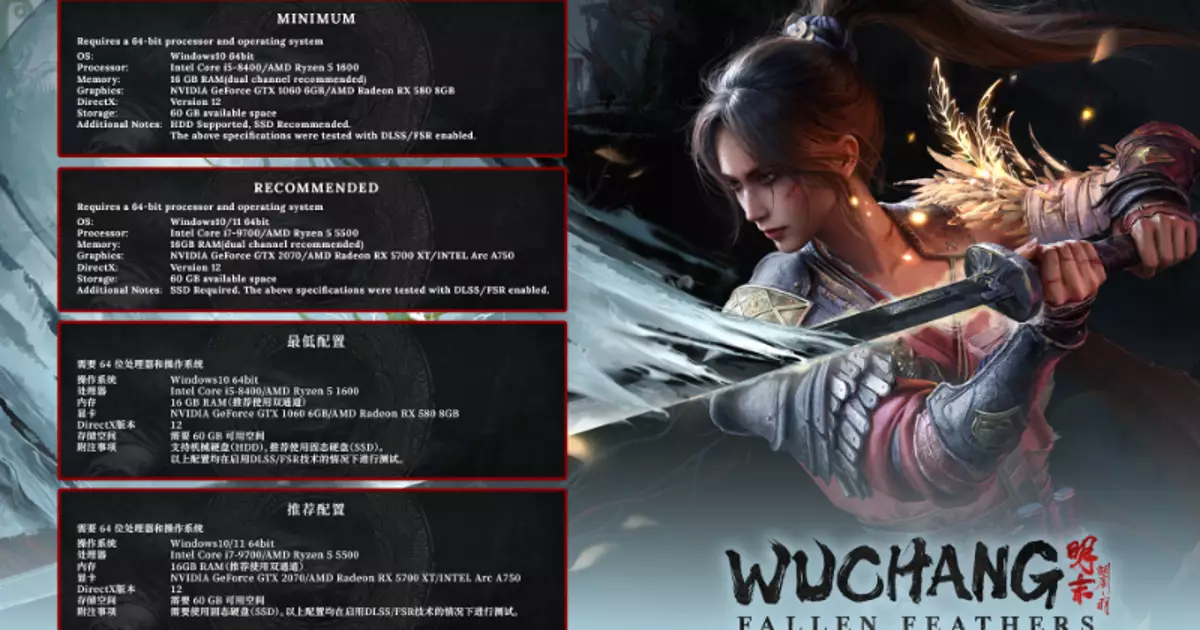In the rapidly evolving landscape of video gaming, the advent of titles like Wuchang: Fallen Feathers signifies a commendable shift toward making visually demanding and mechanically rich experiences accessible to a broader audience. The game’s modest system requirements challenge the traditional notion that high-fidelity graphics and complex gameplay necessitate high-end hardware, democratizing the genre for players with mid-tier or older PCs. By setting the bar at an Intel Core i5-8400 and a GTX 1060, the developers implicitly recognize the importance of inclusivity, ensuring that more gamers can partake in the fantastical world during the age of the Ming dynasty. Such a strategic approach not only expands the potential player base but also underscores a pivotal trend: engaging storytelling and captivating gameplay can coexist with affordable hardware specifications.
This approach fosters a gaming culture that values innovation over raw graphical supremacy. It pushes developers to optimize their code and design mechanics that shine without demanding the latest, most expensive hardware. This phenomenon has the potential to rejuvenate the genre, encouraging smaller studios to take creative risks without the fear of excluding a sizable portion of their audience due to technical constraints.
Balancing Aesthetic Ambition and Technical Constraints
While the physical hardware requirements for Wuchang are modest, the game’s visual ambitions and storytelling depth suggest that high-quality artistry is still possible within these constraints. Recent adjustments to improve the aesthetic palette indicate a conscious effort to craft a visually compelling world without relying solely on high-polygon models or ultra-realistic textures. Instead, developers have focused on atmospheric design, lighting, and stylized visuals that complement the game’s dark, plague-ridden environment known as Shu.
This careful balancing act demonstrates a nuanced understanding that visual storytelling does not have to be sacrificed for accessibility. Artistic creativity, when paired with technical efficiency, can enrich immersive worlds while ensuring broader compatibility. The developers’ willingness to refine and iterate indicates a commitment to delivering an experience that is both aesthetically engaging and technically inclusive.
Gameplay Depth with Technical Simplicity
Beyond mere visuals, Wuchang promises a layered gameplay experience characterized by multiple endings, strategic combat, and exploration of a plague-stricken world teeming with boss fights and upgrade systems. The mechanics leverage systems like “Red Mercury” for unlocking new techniques and enchanting weapons—features that deepen the gameplay loop without requiring excessive hardware power.
This emphasis on gameplay complexity over graphical bells and whistles signifies a maturating of the genre’s philosophy: players value design depth, meaningful choice, and narrative payoff. The game’s ability to deliver a compelling adventure with relatively light system demands reinforces the idea that engaging mechanics and storytelling are paramount, regardless of hardware limitations.
The Path Forward for Action-RPGs
Wuchang’s hardware-efficient design sets a precedent that could influence future developments across genres. As gamers increasingly seek titles that run seamlessly on a variety of systems, developers are compelled to innovate in optimization, art style, and system design. This could lead to a renaissance of creative, yet accessible, gaming experiences that focus on artistic storytelling and innovative mechanics over sheer hardware fidelity.
In an era where every new game often demands the latest GPU or CPU, Wuchang’s approach demonstrates the viability of a different paradigm—one that values inclusive play, strategic gameplay, and artistic expression over ostentatious visual hardware requirements. It champions a future where technological capacity no longer dictates artistic ambition, fostering a gaming ecosystem that celebrates ingenuity and resourcefulness.
In essence, Wuchang’s modest system requirements are a beacon for the industry—proof that gaming’s future can be bright, inclusive, and richly engaging without necessitating the most cutting-edge hardware. This is an exciting evolution, one that promises to bring adventure to more players and inspire developers to prioritize creativity and accessibility alongside technical prowess.


Leave a Reply